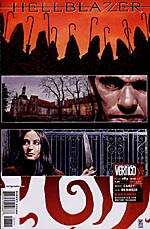 Written by Mike Carey
Written by Mike Carey
Art by Lee Bermejo
32 pages, color
Published by Vertigo/DC Comics
When DC Comics began its Vertigo imprint ten years ago, six existing titles were shifted into its offices: Animal Man, Doom Patrol, Hellblazer, Sandman, Shade, the Changing Man, and Swamp Thing. At the time, Swamp Thing was the longest-running book to make the shift, and was often predicted to be the book that would outlast all of its brethren. While Swamp Thing ended with #171, and four of the other “anchor” ongoing series for Vertigo have also come to an end, one of them is still being published ten years later. Reading the latest story in the pages of Hellblazer, it’s not hard to see why the book is still going strong.
In St. Peter’s Psychiatric Hospital, a patient found something strange at the bottom of an old elevator shaft. It looked like a hole, at first. But the longer you studied it, the larger it got—but no one was ready for just what was ready to come through. Now St. Peter’s is overrun by strange spirits and carnivorous black flowers, and in the nearby town a group of masked figures are sweeping through with chained hooks and staves, destroying all those affected in their path. What John Constantine is really worried about, though, is that this could really only be the tip of the iceberg for something much, much worse.
Each writer to tackle the character of John Constantine has given him their own unique stamp, and Mike Carey is no exception to that. His Constantine is much more of a reactive than proactive character, but “Black Flowers”, like the rest of Carey’s stories to date, is careful to keep the character interesting and a strong protagonist. He’s accomplishing this in part by bringing Constantine’s occult knowledge and abilities to the forefront much more than in recent years. It’s almost a polar opposite approach than the one recently employed by Brian Azzarello, even while serving as a complement to Azzarello’s stories rather than a complaint. Most importantly, though, Carey’s showing his ability to write good old-fashioned horror in “Black Flowers”; it’s got the creepy figures, the menacing side-effects, and a lot of tension and atmosphere to keep the reader’s breath caught until the climactic moment. Carey’s able to keep Constantine unpredictable and intriguing here, using the mystery of the character for a much more exciting conclusion.

It’s always a pleasure to see comics by Lee Bermejo, and his two issues here for Hellblazer are no exception. Bermejo’s art is full of patterned geometric black inks and angular edges, for a real distinctive yet beautiful style. At a casual glance it would be easy to say that Bermejo avoids putting in detail, but anyone who looks closely will discover that’s not the case. Bermejo’s inks create a sense of texture on the printed page, and his characters look so lifelike you’d think they were staring at you. In a story as dark and atmospheric as “Black Flowers”, you need someone like Bermejo who understands that sometimes the scariest things are the ones lurking in the shadows… and how to then make them even scarier when they jump into the light.
For a book as long-running as Hellblazer, it would be easy to guess that there was only so long until it ran out of steam. Carey and Bermejo prove that’s not the case here; Hellblazer is still fresh and original, a real joy to read every month. If you’ve never read Hellblazer before but wouldn’t mind a little horror in your life, Carey’s work on the book is a great place to start.
